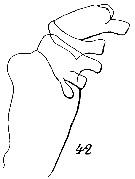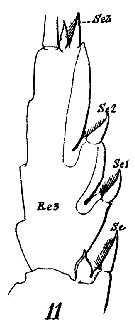|
|
 |
|
Calanoida ( Order ) |
|
|
|
Clausocalanoidea ( Superfamily ) |
|
|
|
Euchaetidae ( Family ) |
|
|
|
Paraeuchaeta ( Genus ) |
|
|
| |
Paraeuchaeta grandiremis (Giesbrecht, 1888) (F,M) | |
| | | | | | | Syn.: | Euchäta grandiremis Giesbrecht, 1888; 1892 (p.246, 264, 772, Descr.F, figs.F);
Euchaeta grandiremis : Giesbrecht & Schmeil, 1898 (p.41, Rem. F); Wolfenden, 1911 (p.299); Vervoort, 1957 (p.77); Volkov, 1970 a (p.353, Descr.M); 1970 b (p.355 : figs.M);
Pareuchaeta grandiremis : Wilson, 1942 a (p.201); C.B. Wilson, 1950 (p.281, figs.F,M); Heinrich, 1990 (p.17) | | | | Ref.: | | | Park, 1995 (p.93, Redescr.F, Descr.M, figs.F,M) |  issued from : T. Park in Bull. Scripps Inst. Oceanogr. Univ. California, San Diego, 1995, 29. [p.198, Fig.88]. Female: a, habitus (left side); b, forehead (left); c, urosome (left); d, e, genital somite (left, right, respectively); f, right caudal ramus (dorsal); g, A2; h, Mx1 (first inner lobe separated), posterior; i, Mx2 (4th and 5th lobes and endopod separated), posterior; j, endopod of Mxp (anterior); k, P1; l, P2, m, P3. P1-3 = swimming legs 1-3 (anterior). Nota: A1 extraordinaly long, extending beyond distal end of caudal ramus by at last 5 segments or by about 1/3 its length (however, A1 similar to that of P. malayensis. 1st pedigerous somite separated from cephalosome by a clear line of joint. Rostrum small, pointing straight in an anteroventral direction. Supralabrum relatively short, pointing obliquely forward roughly in parallel to rostrum. A2: coxa, basis, and 1st endopodal segment each with a conspicuous swelling at proximal end. Md: similar to that of P. malayensisMx1: with 1+7+1 setae on 1st inner lobe, no seta on 2nd, and 1seta on 3rd; 5 setae on basis (of which the small innermost seta was absent in many specimens), 2 setae on 1st endopodal segment. Exopod with 10 long setae and similar to that of P. malayensis but with a high swelling on posterior margin proximal to 1st lobe. Mxp also similar to that of P. malayensis except that 2nd and 4th endopodal segments each with 2 setae (instead of 3). 1st exopodal segment of P1 not separated from 2nd, without an outer spine; its outer margin only slightly bulging. Outer spine of 2nd segment relatively small, reaching about 1/3 way to base of following outer spine. In P2 exopod, last 4 outer spines of similar size, only a little longer than 1st. First 2 marginal lobes bearing outer spines in 3rd exopodal segment each separated from segment by moderately deep incision. Exopod of P3 similar to that of P2.
|
 issued from : T. Park in Bull. Scripps Inst. Oceanogr. Univ. California, San Diego, 1995, 29. [p.199, Fig.89]. Male: a, habitus (left side); b, forehead (left); c, caudal rami (ventral); d, P1; e, P2; f, P5; g, h, distal exopodal segments of left 5th leg (lateral, medial, respectively); i, serrated lamella (lateral). P1-5 = legs (anterior). Nota: Fusion between cephalosome and 1st pedigerous somite complete. Forehead in lateral view similar to that of female, but rostrum larger and slightly curved backward. Posterolateral corners of prosome symmetrical and rounded, with a toothlike process on dorsal margin. A1 extending beyond distal end of caudal ramus by its last 2 or 3 segments. All cephalosomal appendages similar to those of P. malayensis. 1st exopodal segment of P1 almost fully separated from 2nd, without an outer spine; outer spine of 2nd segment relatively small, pointing distad. P2 to P4 similar to those of female. Appendicular caudal seta originating from a cylindrical base, smoothly curved, about 1/2 length of 3nd or 5th marginal caudal seta; 4th marginal caudal seta longer than 3rd or 5th by 2/5 its length.
|
 Issued from : W. Giesbrecht in Systematik und Faunistik der Pelagischen Copepoden des Golfes von Neapel und der angrenzenden Meeres-Abschnitte. - Fauna Flora Golf. Neapel, 1892, 19 , Atlas von 54 Tafeln. [Taf.37, Figs.41, 42]. As Euchäta grandiremis. Female: 41, urosome with spermatophore (lateral); 42, urosome (dorsal).
|
 Issued from : W. Giesbrecht in Systematik und Faunistik der Pelagischen Copepoden des Golfes von Neapel und der angrenzenden Meeres-Abschnitte. - Fauna Flora Golf. Neapel, 1892, 19 , Atlas von 54 Tafeln. [Taf.16, Fig.42]. As Euchäta grandiremis. Female: 42, outline basis 1 and 2 of Mx2.
|
 Issued from : W. Giesbrecht in Systematik und Faunistik der Pelagischen Copepoden des Golfes von Neapel und der angrenzenden Meeres-Abschnitte. - Fauna Flora Golf. Neapel, 1892, 19 , Atlas von 54 Tafeln. [Taf.16, Fig.11]. As Euchäta grandiremis. Female: 11, exopodite 3 of P2 (posterior view).
| | | | | Compl. Ref.: | | | Sewell, 1948 (p.348, 501); Fagetti, 1962 (p.22); Bradford & al., 1983 (p.23); Brinton & al., 1986 (p.228, Table 1); Park, 1994 (p.320); Suarez-Morales & Gasca, 1998 a (p.109); Park & Ferrari, 2009 (p.143, Table 8, biogeography) | | | | NZ: | 4 | | |
|
Distribution map of Paraeuchaeta grandiremis by geographical zones
|
| | | | Loc: | | | California, Gulf of California, W Colombia, off Galapagos, NE Tuamotu Is., NE Easter Is., Peru, Pacif. (SE (tropical, off N Chile, [ E Cape Verde Is. (in Wolfenden, 1911), off NW St. Peter & St. Paul Rocks (in Wilson, 1942 a, p.32) ] | | | | N: | 7 | | | | Lg.: | | | (3) F: 5,8-5,2; M: 4,7-4,4; (47) F: 5,2; {F: 5,20-5,80; M: 4,40-4,70} | | | | Rem.: | Meso-bathypelagic.
After Wilson (1942 a, p.201) this species was originally obttained by Giesbrecht (1892) from the eastern equatorial Pacific between 11°N and 3°S and between 99°W and 124°W, from a depth of 1000 m. A few specimens were found in the 100 meter tow in the tropical Atlantic (8°15'N, 36°10'W, first record of this species).
The male P5, figured in Volkov and Park are not compatible.
Park (1995) does not retain the presence of this species in the Atlantic Ocean. In his samples the species was found, often in large numbers, in the eastern tropical Pacific, between 3°N and 13°N and between the west coast of America and 150°W, and along the west coast of South America between 13°N and 24°S.
For Park (1995, p.94) this species differs from P. malayensis in anatomical features of the appendages in the following respects; Basis and 1st endopodal segment of A2 each with a single seta and 2nd exopodal segment without a seta. First inner lobe of Mx1 with 1+7+1 setae; 2nd inner lobe with no seta; small outermost seta on Mx1 basis is missing; 1st endopodal segment of Mx1 with 2 setae. Mx2 with a large outgrowth on posterior margin. Endopodal segments 2 and 4 of Mxp each with 2 setae. First 2 exopodal segments of P1 fully fused; outer spine of 1st segment missing.. The male is diagnosed by its long A1, large tubercle on the 1st exopodal segment of the right P5, small spiniform endopod of the left P5, triangular outgrowth on the 1st exopodal segment of left P5, and elongate serrated lamella and digitiform process of the 2nd exopodal segment. | | | Last update : 18/11/2022 | |
|
|
 Any use of this site for a publication will be mentioned with the following reference : Any use of this site for a publication will be mentioned with the following reference :
Razouls C., Desreumaux N., Kouwenberg J. and de Bovée F., 2005-2025. - Biodiversity of Marine Planktonic Copepods (morphology, geographical distribution and biological data). Sorbonne University, CNRS. Available at http://copepodes.obs-banyuls.fr/en [Accessed August 17, 2025] © copyright 2005-2025 Sorbonne University, CNRS
|
|
 |
 |








